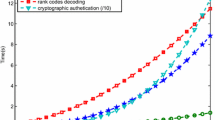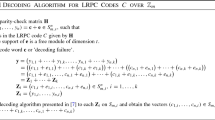Abstract
We study the problem of reducing the communication overhead from a noisy wire-tap channel or storage system where data is encoded as a matrix, when more columns (or their linear combinations) are available. We present its applications to reducing communication overheads in universal secure linear network coding and secure distributed storage with crisscross errors and erasures and in the presence of a wire-tapper. Our main contribution is a method to transform coding schemes based on linear rank-metric codes, with certain properties, to schemes with lower communication overheads. By applying this method to pairs of Gabidulin codes, we obtain coding schemes with optimal information rate with respect to their security and rank error correction capability, and with universally optimal communication overheads, when n ≤ m, being n and m the number of columns and number of rows, respectively. Moreover, our method can be applied to other families of maximum rank distance codes when n > m. The downside of the method is generally expanding the packet length, but some practical instances come at no cost.
Similar content being viewed by others
References
Ahlswede, R., Cai, N., Li, S.Y.R., Yeung, R.W.: Network information flow. IEEE Trans. Inform. Theory 46(4), 1204–1216 (2000)
Bitar, R., Rouayheb, S.E.: Staircase codes for secret sharing with optimal communication and read overheads. IEEE Trans. Inform. Theory PP(99), 1–15 (2017)
Cover, T.M., Thomas, J.A.: Elements of Information Theory (Wiley Series in Telecommunications and Signal Processing), 2nd edn. Wiley-Interscience, New York (2006)
Delsarte, P.: Bilinear forms over a finite field, with applications to coding theory. J. Combinatorial Theory Series A 25(3), 226–241 (1978)
Dimakis, A.G., Godfrey, P.B., Wu, Y., Wainwright, M.J., Ramchandran, K.: Network coding for distributed storage systems. IEEE Trans. Inform. Theory 56(9), 4539–4551 (2010)
Dimakis, A.G., Ramchandran, K., Wu, Y., Suh, C.: A survey on network codes for distributed storage. Proc. IEEE 99(3), 476–489 (2011)
Gabidulin, E.M., Ourivski, A.V., Honary, B., Ammar, B.: Reducible rank codes and their applications to cryptography. IEEE Trans. Inform. Theory 49(12), 3289–3293 (2003)
Gabidulin, E.M.: Theory of codes with maximum rank distance. Probl. Inf. Transm. 21(1), 1–12 (1985)
Gopalan, P., Huang, C., Simitci, H., Yekhanin, S.: On the locality of codeword symbols. IEEE Trans. Inform. Theory 58(11), 6925–6934 (2012)
Guruswami, V., Wootters, M.: Repairing Reed-Solomon codes. In: Proc. 48th Annual ACM Symposium on Theory of Computing. ACM, pp. 216–226 (2016)
Ho, T., Medard, M., Koetter, R., Karger, D., Effros, M., Shi, J., Leong, B.: A random linear network coding approach to multicast. IEEE Trans. Inform. Theory 52(10), 4413–4430 (2006)
Huang, C., Chen, M., Li, J.: Pyramid codes: Flexible schemes to trade space for access efficiency in reliable data storage systems. In: Sixth IEEE International Symposium on Network Computing and Applications (NCA 2007), pp. 79–86 (2007)
Huang, W., Langberg, M., Kliewer, J., Bruck, J.: Communication efficient secret sharing. IEEE Trans. Inform. Theory 62(12), 7195–7206 (2016)
Kadhe, S., Rouayheb, S.E., Duursma, I., Sprintson, A.: Rank-metric codes with local recoverability. In: Proc. 54th Annual Allerton Conference on Communication, Control and Computing (2016)
Kötter, R., Medard, M.: An algebraic approach to network coding. IEEE/ACM Trans. Networking 11(5), 782–795 (2003)
Kurihara, J., Matsumoto, R., Uyematsu, T.: Relative generalized rank weight of linear codes and its applications to network coding. IEEE Trans. Inform. Theory 61(7), 3912–3936 (2015)
Li, S.Y., Yeung, R., Cai, N.: Linear network coding. IEEE Trans. Inform. Theory 49(2), 371–381 (2003)
Martínez-Peñas, U.: On the similarities between generalized rank and Hamming weights and their applications to network coding. IEEE Trans. Inform. Theory 62(7), 4081–4095 (2016)
Martínez-Peñas, U.: Universal secure rank-metric coding schemes with optimal communication overheads. In: Proc 2017 IEEE International Symposium on Information Theory (ISIT), pp. 2761–2765 (2017)
Rashmi, K.V., Shah, N.B., Kumar, P.V.: Optimal exact-regenerating codes for distributed storage at the MSR and MBR points via a product-matrix construction. IEEE Trans. Inform. Theory 57(8), 5227–5239 (2011)
Roth, R.M.: Maximum-rank array codes and their application to crisscross error correction. IEEE Trans. Inform. Theory 37(2), 328–336 (1991)
Silva, D., Kschischang, F.R.: Universal secure network coding via rank-metric codes. IEEE Trans. Inform. Theory 57(2), 1124–1135 (2011)
Tamo, I., Barg, A.: A family of optimal locally recoverable codes. IEEE Trans. Inform. Theory 60(8), 4661–4676 (2014)
Wang, H., Wong, D.S.: On secret reconstruction in secret sharing schemes. IEEE Trans. Inform. Theory 54(1), 473–480 (2008)
Acknowledgments
The author is thankful for the guidance of his advisors Olav Geil and Diego Ruano. This manuscript was written in part when the author was visiting the University of Toronto. He greatly appreciates the support and hospitality of Frank R. Kschischang, and is thankful for valuable discussions on this work. Finally, the author wishes to thank the anonymous reviewers for their very helpful comments.
Author information
Authors and Affiliations
Corresponding author
Additional information
This work was supported by The Danish Council for Independent Research under Grant No. DFF-4002-00367 and Grant No. DFF-5137-00076B (“EliteForsk-Rejsestipendium”).
Parts of this paper have been presented at the IEEE International Symposium on Information Theory, Aachen, Germany, June 2017. [19].
Appendix A: Proof of Lemma 3
Appendix A: Proof of Lemma 3
We start with an auxiliary result, which is a particular case of [18, Th. 3]:
Lemma 4 ([ 18 ])
Let\( B \in \mathbb {F}_{q}^{\mu \times n} \)and let\( \mathcal {C}_{2} \subsetneqq \mathcal {C}_{1} \subseteq \mathbb {F}_{q^{m}}^{n} \)be\( \mathbb {F}_{q^{m}} \)-linearcodes. It holds that
where\( \text {Row}(A) \subseteq \mathbb {F}_{q^{m}}^{n} \)denotes the\( \mathbb {F}_{q^{m}} \)-linear vector space generated by the rows of the matrix\( A \in \mathbb {F}_{q}^{\nu \times n} \).
With this auxiliary result, we may now prove Lemma 3, which we now recall:
Lemma 3
Let\( B \in \mathbb {F}_{q}^{\mu \times n} \)andlet\( \mathcal {C}_{2} \subsetneqq \mathcal {C}_{1} \subseteq \mathbb {F}_{q^{m}}^{n} \)be\( \mathbb {F}_{q^{m}} \)-linearcodes. If\( \text {Rk}(B) < d_{R} \left (\mathcal {C}_{2}^{\perp }, \mathcal {C}_{1}^{\perp } \right ) \),then
where\( \mathcal {C} B^{T} = \left \lbrace \mathbf {c} B^{T} \mid \mathbf {c} \in \mathcal {C} \right \rbrace \subseteq \mathbb {F}_{q^{m}}^{\mu } \), for a code\( \mathcal {C} \subseteq \mathbb {F}_{q^{m}}^{n} \).
Proof
Given an \( \mathbb {F}_{q^{m}} \)-linear code \( \mathcal {C} \subseteq \mathbb {F}_{q^{m}}^{n} \), consider the map \( \mathcal {C} \longrightarrow \mathcal {C} B^{T} \) defined by c ↦ cBT, for \( \mathbf {c} \in \mathcal {C} \). It is surjective and its kernel is \( \mathcal {C} \cap \left (\mathcal {V}^{\perp } \right ) \), where \( \mathcal {V} = \text {Row}(B) \). Therefore
Using this equation and computing dimensions, it follows that
Now, using that \( \text {Rk}(B) < d_{R} \left (\mathcal {C}_{2}^{\perp }, \mathcal {C}_{1}^{\perp } \right ) \)and thep revious lemma, it holds that \( \mathcal {C}_{2}^{\perp } \cap \mathcal {V} = \mathcal {C}_{1}^{\perp } \cap \mathcal {V} \). Hence the result follows by (19). □
Rights and permissions
About this article
Cite this article
Martínez-Peñas, U. Universal secure rank-metric coding schemes with optimal communication overheads. Cryptogr. Commun. 11, 147–166 (2019). https://doi.org/10.1007/s12095-018-0279-4
Received:
Accepted:
Published:
Issue Date:
DOI: https://doi.org/10.1007/s12095-018-0279-4
Keywords
- Communication overheads
- Crisscross error-correction
- Decoding bandwidth
- Information-theoretical security
- Rank-metric codes




